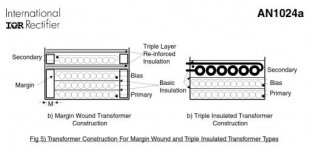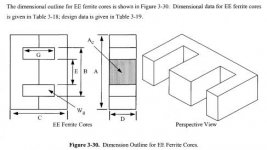This is an official update of the transformer primary calculation constant list.
Np = (Vmax * 10 ^ 8) / (X * F * B * Ae)
Np = Number of primary turns
The constant X used in the primary turns formula can be any of the following.
1.11 - compensates for the sine wave ratio of RMS to average voltage. This constant is not used by itself.
1 - Used for half wave, square wave operation of a transformer. A flyback converter uses this constant. Also a one and two transistor forward converter. The hysteresis curve (flux swing) only uses one quadrant.
2 - This is the square wave constant above multiplied by 2. there are two semi cycles in each full cycle (Hertz refers to full cycles). An Interleaved forward converter (two, one transistor forward converters Interleaved together) gives two power pulses per period. The hysteresis curve (flux swing) only uses one quadrant.
4 - This is the constant 2 above multiplied by two for topographies that have a hysteresis curve (flux swing) in both quadrants, like a full bridge circuit, half bridge or push pull.
4.44- Used for standard sine wave transformer design. This is the result of the constants above.
1.11 x 2 semi cycles in each full cycle x 2 flux swing in both quadrants.
Hopefully this is correct now. I only use the 4 constant so i have verified that one many times, but i have never used the others.
Np = (Vmax * 10 ^ 8) / (X * F * B * Ae)
Np = Number of primary turns
The constant X used in the primary turns formula can be any of the following.
1.11 - compensates for the sine wave ratio of RMS to average voltage. This constant is not used by itself.
1 - Used for half wave, square wave operation of a transformer. A flyback converter uses this constant. Also a one and two transistor forward converter. The hysteresis curve (flux swing) only uses one quadrant.
2 - This is the square wave constant above multiplied by 2. there are two semi cycles in each full cycle (Hertz refers to full cycles). An Interleaved forward converter (two, one transistor forward converters Interleaved together) gives two power pulses per period. The hysteresis curve (flux swing) only uses one quadrant.
4 - This is the constant 2 above multiplied by two for topographies that have a hysteresis curve (flux swing) in both quadrants, like a full bridge circuit, half bridge or push pull.
4.44- Used for standard sine wave transformer design. This is the result of the constants above.
1.11 x 2 semi cycles in each full cycle x 2 flux swing in both quadrants.
Hopefully this is correct now. I only use the 4 constant so i have verified that one many times, but i have never used the others.




